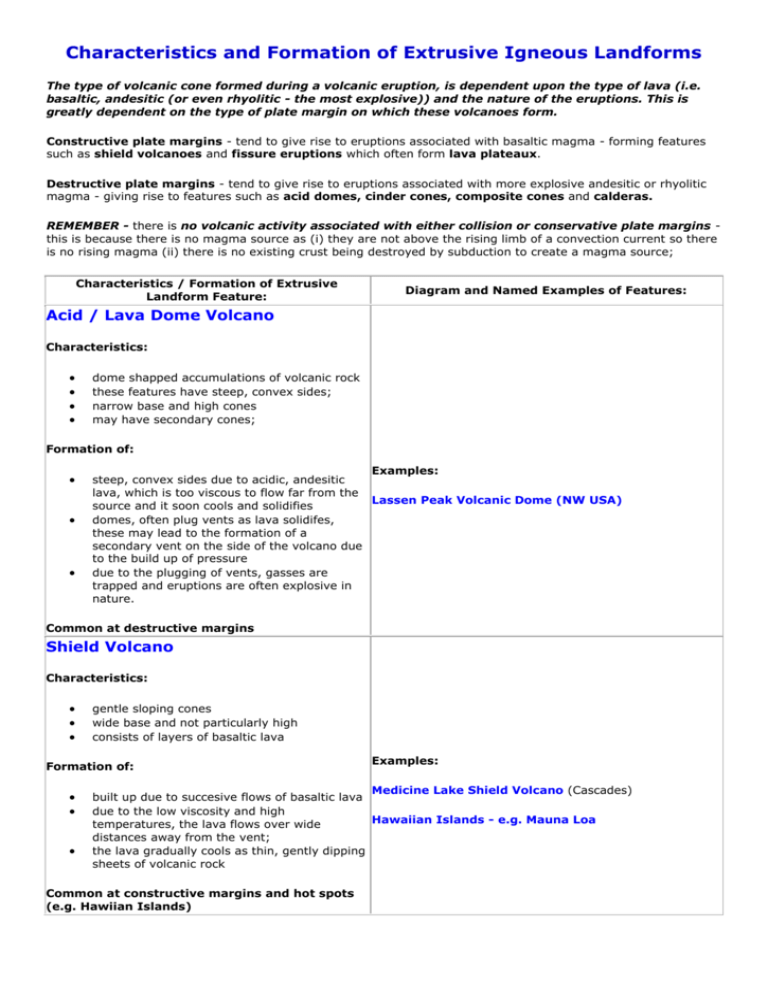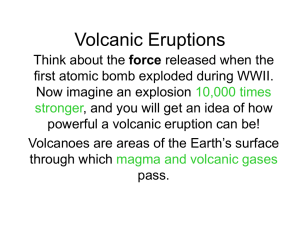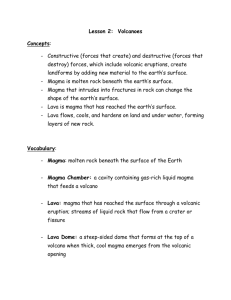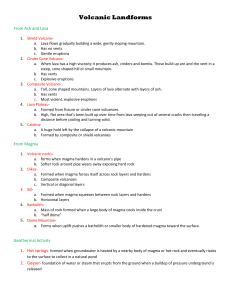Characteristics and Formation of Extrusive Igneous Landforms
advertisement

Characteristics and Formation of Extrusive Igneous Landforms The type of volcanic cone formed during a volcanic eruption, is dependent upon the type of lava (i.e. basaltic, andesitic (or even rhyolitic - the most explosive)) and the nature of the eruptions. This is greatly dependent on the type of plate margin on which these volcanoes form. Constructive plate margins - tend to give rise to eruptions associated with basaltic magma - forming features such as shield volcanoes and fissure eruptions which often form lava plateaux. Destructive plate margins - tend to give rise to eruptions associated with more explosive andesitic or rhyolitic magma - giving rise to features such as acid domes, cinder cones, composite cones and calderas. REMEMBER - there is no volcanic activity associated with either collision or conservative plate margins this is because there is no magma source as (i) they are not above the rising limb of a convection current so there is no rising magma (ii) there is no existing crust being destroyed by subduction to create a magma source; Characteristics / Formation of Extrusive Landform Feature: Diagram and Named Examples of Features: Acid / Lava Dome Volcano Characteristics: dome shapped accumulations of volcanic rock these features have steep, convex sides; narrow base and high cones may have secondary cones; Formation of: Examples: steep, convex sides due to acidic, andesitic lava, which is too viscous to flow far from the Lassen Peak Volcanic Dome (NW USA) source and it soon cools and solidifies domes, often plug vents as lava solidifes, these may lead to the formation of a secondary vent on the side of the volcano due to the build up of pressure due to the plugging of vents, gasses are trapped and eruptions are often explosive in nature. Common at destructive margins Shield Volcano Characteristics: gentle sloping cones wide base and not particularly high consists of layers of basaltic lava Formation of: Examples: Medicine Lake Shield Volcano (Cascades) built up due to succesive flows of basaltic lava due to the low viscosity and high Hawaiian Islands - e.g. Mauna Loa temperatures, the lava flows over wide distances away from the vent; the lava gradually cools as thin, gently dipping sheets of volcanic rock Common at constructive margins and hot spots (e.g. Hawiian Islands) Cinder Cone Characteristics: Slightly concave sides consist of successive layers of material (ash and cinders) Formation of: largest materials fall closest to the summit forming steep but stable sides close to the vent finer materials are carried further away and form gentle slopes at the base of the cone. Examples: Lava Butte, Oregon (Cascades) Composite Cone / Stratovolcano Characteristics: often very large structures with steep and fairly symmetrical sides; consist of alternating layers of acidic lava and ash; often has parasitic or secondary cone (several are common due to earlier eruptions); Formation of: These cones are associated with andesitic magma, during violent eruptions, when the Examples: vent has been blocked, ash and other pyroclasts are produced during the eruption; Mount St Helens, Washington State (Cascades) In subsequent less explosive eruptions, lava may be released - giving rise to the alternating layers of lava and ash; these cones hava conduit system through which magma rises to the surface, solidfied lava in the conduit system helps to strengthen the cone; Where the passage of magma becomes blocked and pressure builds, magma may flow from fissures on the volcanoes flank, forming parasitic or secondary cones. Common at destructive boundaries (subduction zones) Caldera Characteristics: large. steep walled, basin shaped depressions; ofen have a lake (or lagoon, if below sealevel) inside the crater may have new volcanic cones growing inside; Examples: Formation of: Formed due to highly explosive volcanic activity - fresh andesitic magma entering and filling the magma chamber, may trigger a highly explosive volcanic (eruption) (diagram 2) Crater Lake Caldera, Oregon As the eruption progresses, the magma chamber gradually empties and there is no magma left to support the roof of the chamber. The mountain summit therefore collapses into the chamber creating a caldera (earth movements may cause further subsidence of the sides); (diagram 3) The bowl-shaped depression often fills with water, forming a lake (or lagoon, if below sealevel); If new magma continues to rise, small, new volcanic cones may form within the caldera (e.g. Crater Lake) After 1000s of years, fresh magma may enter the magma chamber causing it to re-inflate and the caldera floor to dome up as a Resurgent Caldera when these erupt, they can be the most destructive natural phenomenum on earth. They form as large amounts of highly viscous and explosive rhyoltic magma rises to the surface. Lava Plateaux Characteristics: Extensive, flat / very gentle sloping, Layered structure (layers of lava from series of eruptions over time) flat, featureless (usually limited soil / vegetation cover) Formation of: Lava Plateaux are formed during fissure eruptions, where basalt lavas (known as flood basalts) pour out of cracks in the surface (fissures) rather than from a central vent; as the lava is runny (low viscosity) and takes Examples: a long time to cool, it travels long distances Columbia Plateau - NW USA (Cascades area) from the fissure; these features are layered structures caused by the accumulation of lava over a series of Deccan Plateau - NW India lava flows, forming as broad plateaux rather than piling up as a volcanic mountain; slow cooling can lead to the formation of columnar jointing; Rivers often cut across the lava plateau, forming gorges - for example the Columbia river which has cut across the Columbia Plateau The Deccan Plateau is a huge expanse of lava covering an area of 700,00km2 and consisting of 29 lava flows which have occured within the last 2 million years. A number of river valleys (including the Wardha river) are eroded into the plateau which lies at 700-900m above sea level.







